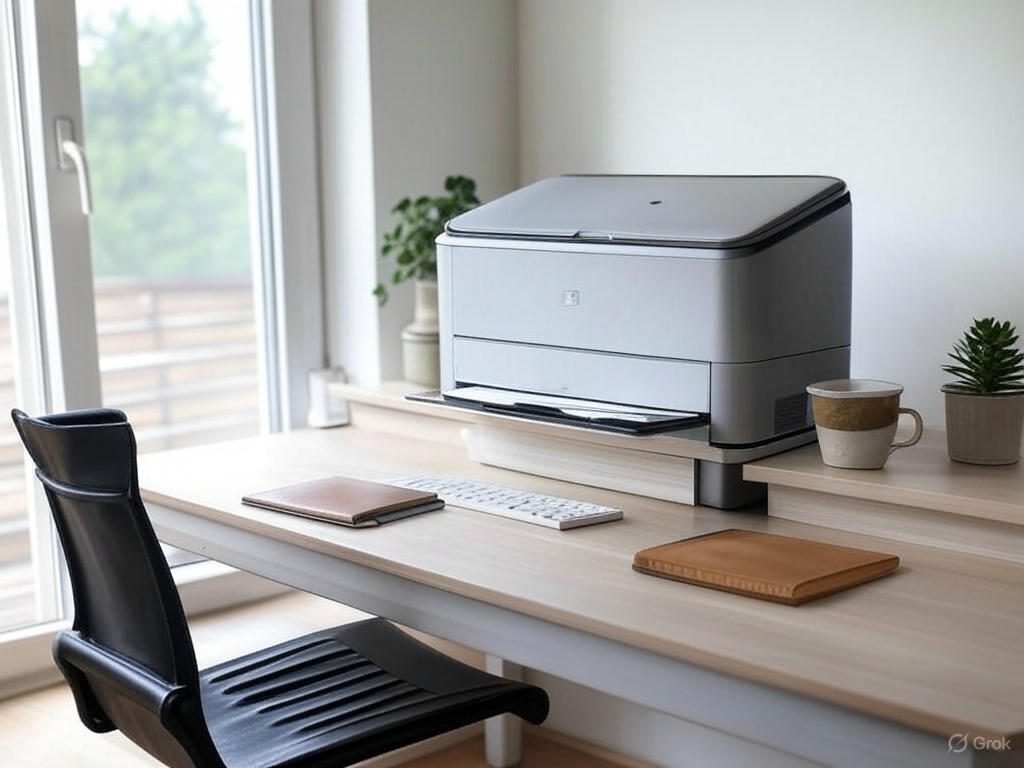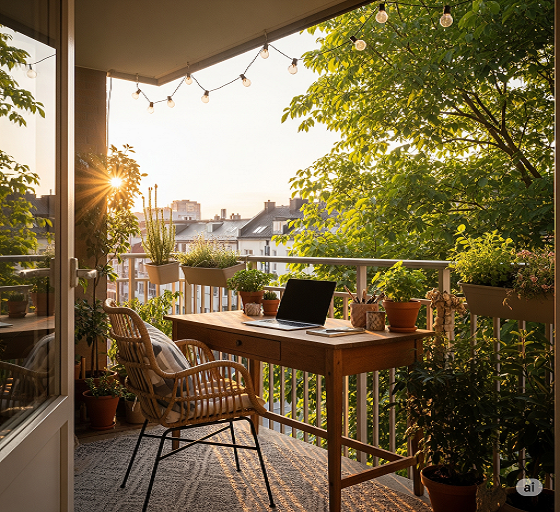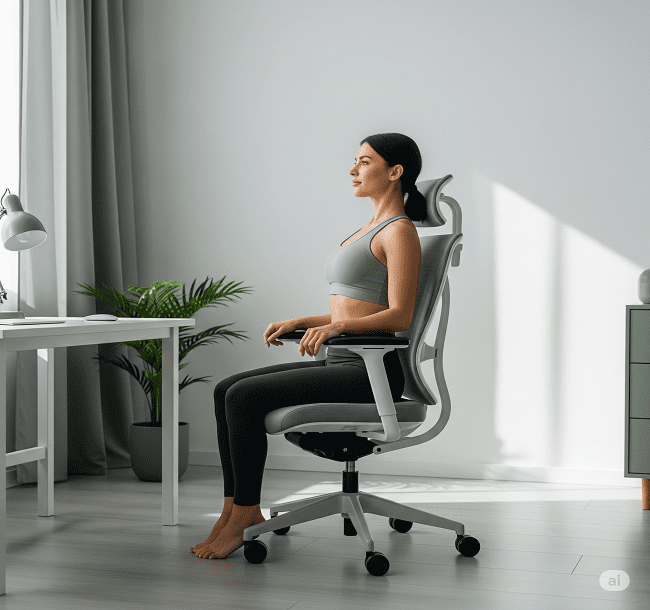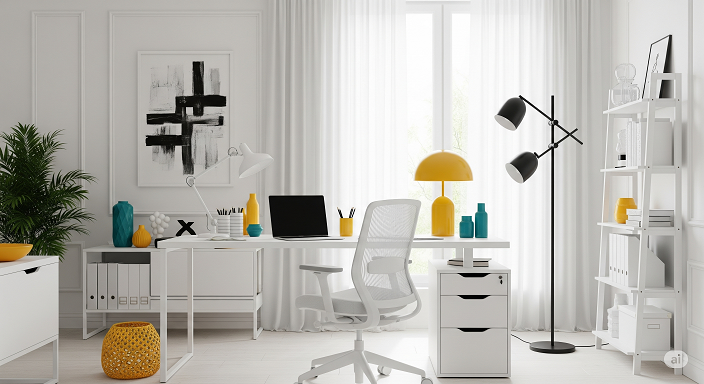
Good Home Office Printer: The Ultimate Guide to Finding the Best Picks in 2025
Affiliate Disclosure: As an Amazon Associate, we may earn from qualifying purchases. This helps support HushDesk at no extra cost to you.
Reader’s Guide
As someone who has spent countless hours designing and perfecting my home workspace, I’ve come to realize that a good home office printer is far more than just a peripheral device—it’s a productivity cornerstone. Whether you’re submitting time-sensitive documents, printing presentations for clients, or simply need physical copies of important files, the right printer can streamline your workflow in ways you might not expect.
The shift toward remote work has transformed our printing needs. No longer can we rely on the office behemoth down the hall or a quick trip to the local print shop. Instead, our home offices require devices that balance quality, efficiency, and affordability. After years of testing various models and hearing feedback from fellow work-from-home enthusiasts, I’m excited to share insights that will help you find the perfect home office printer for your unique needs.
Understanding Your Home Office Printing Needs
Before diving into specific printer recommendations, take a moment to reflect on your actual printing habits. This might seem obvious, but I’ve found that many people either overestimate or underestimate their requirements, leading to frustration and wasted resources.
Start by asking yourself: How many pages do you typically print each week? If you’re printing less than 100 pages monthly, a standard home printer will likely suffice. However, if your printing volume exceeds 500 pages monthly, you’ll want to consider more robust options designed for higher capacities.
Next, consider what you’re printing. Are you primarily handling text documents like contracts and reports? Or does your work involve vivid graphics, marketing materials, or high-quality photographs? The content you print directly impacts the type of printer technology that will serve you best.
Your budget is another crucial factor, but don’t focus solely on the initial purchase price. A $75 printer might seem appealing until you discover that replacement ink cartridges cost nearly as much as the device itself. Instead, consider the total cost of ownership over 2-3 years, including consumables like ink or toner.
Remember that your printing needs may evolve, especially as remote work continues to shape how we operate. The ideal home office printer should accommodate your current requirements while offering enough flexibility to adapt to changing demands.
Types of Home Office Printers Explained
The printer market offers several technologies, each with distinct advantages depending on your specific needs:
Inkjet printers remain popular for home offices due to their versatility and relatively low initial cost. These devices spray microscopic ink droplets onto paper, delivering excellent color reproduction that makes them ideal for printing photographs and graphics-heavy documents. Modern inkjets have overcome many historical limitations, with faster print speeds and improved text quality. They’re particularly suitable if your work involves creative elements or occasional photo printing.
Laser printers, by contrast, use toner powder and heat to create precise text documents. While typically more expensive upfront, laser printers often prove more economical over time for text-heavy printing needs. They produce crisp, professional-looking documents at higher speeds than most inkjets, making them perfect for those who primarily print text-based materials like contracts, reports, and correspondence. Color laser printers have become more affordable, though they still command premium prices compared to their monochrome counterparts.
All-in-one (or multifunction) printers combine printing, scanning, copying, and sometimes faxing capabilities in a single device. These space-saving solutions are particularly valuable in compact home offices. Whether inkjet or laser-based, they offer tremendous versatility without requiring multiple machines. I’ve found these to be the sweet spot for most remote workers who need occasional scanning and copying functionality alongside regular printing.
Photo printers represent a specialized category designed specifically for high-quality image reproduction. If your work involves photography, graphic design, or other visual arts, these printers offer color accuracy and detail reproduction that standard devices cannot match. However, they’re less practical for everyday document printing and typically carry higher operational costs.
Essential Features for a Good Home Office Printer
After years of refining my own workspace, I’ve identified several features that separate good home office printers from truly great ones:
Wireless connectivity has evolved from a luxury to a necessity. A good home office printer should connect seamlessly to your Wi-Fi network, enabling printing from multiple devices without cable clutter. Look for printers that support both 2.4GHz and 5GHz networks for optimal performance and compatibility. Mobile printing capabilities further enhance convenience, allowing you to print directly from smartphones and tablets through services like Apple AirPrint or Google Cloud Print.
Automatic duplex (double-sided) printing might seem like a minor feature, but it can significantly impact both your productivity and environmental footprint. This functionality allows the printer to automatically print on both sides of the paper without manual intervention, reducing paper consumption and creating more professional-looking documents.
Paper handling versatility proves invaluable when working from home. The ability to accommodate different paper sizes, weights, and types—from standard letter-size documents to envelopes, labels, and cardstock—eliminates the need for specialized printing services. I recommend printers with at least a 250-sheet capacity to minimize frequent reloading, along with a dedicated bypass tray for occasional specialty media.
Print speed becomes particularly important when preparing for meetings or deadlines. While manufacturers often advertise optimistic figures, look for inkjet printers offering at least 10-15 pages per minute (ppm) for black text and 5-8 ppm for color documents. Laser printers typically deliver 20-30 ppm for monochrome printing, making them substantially faster for text-heavy workloads.
Cloud integration features have transformed how we interact with our printers. The ability to print directly from cloud storage services like Google Drive, Dropbox, or OneDrive—without routing through a computer—streamlines workflows and enhances flexibility. Some advanced models even support voice assistant integration, allowing hands-free operation through Amazon Alexa or Google Assistant.
Top Printer Brands for Home Offices in 2025
While individual models come and go, certain manufacturers have established reputations for reliability and innovation in the home office printer market:
HP (Hewlett-Packard) continues to dominate with its diverse lineup spanning budget-friendly options to premium business-class devices. Their Instant Ink subscription service has revolutionized the consumables market, offering automatic delivery of replacement cartridges based on actual usage rather than arbitrary timeframes. HP’s thermal inkjet technology delivers consistent performance, while their enterprise-grade security features provide peace of mind for those handling sensitive information.
Canon balances exceptional print quality with reasonable operating costs. Their PIXMA series excels at photo reproduction, while their image CLASS laser printers deliver outstanding text clarity. Canon’s proprietary print head technology tends to resist clogging better than some competitors, reducing maintenance headaches for occasional users. Their Mega Tank models use refillable ink tanks that dramatically reduce per-page costs compared to traditional cartridges.
Epson has pioneered eco-friendly printing with their Eco Tank series, which replaces conventional cartridges with refillable reservoirs that can last for thousands of pages. Their precision core print heads deliver excellent detail in both text and images, while their Work Force models offer business-class features at reasonable price points. Epson particularly shines in color accuracy, making them favored among creative professionals.
Brother has carved a niche with practical, reliable printers that emphasize efficiency over flashy features. Their laser printers are renowned for longevity and low maintenance requirements, often outlasting competitors by years rather than months. Brother devices typically offer better paper handling capabilities than similarly priced alternatives, with generous input trays and robust automatic document feeders for scanning and copying.
When comparing brands, consider not just the hardware but the ecosystem around it—software compatibility, driver stability, and customer support quality vary significantly between manufacturers. In my experience, HP and Brother typically offer the most intuitive user experiences, while Canon and Epson excel in print quality and innovative ink systems.
Best Printers for Specific Home Office Scenarios
Finding your ideal printer means matching features to your specific circumstances. Here are my recommendations based on common home office scenarios:
For versatility seekers requiring printing, scanning, and copying capabilities, the HP OfficeJet Pro 9125e stands out as an exceptional all-in-one solution.
- FROM AMERICA’S MOST TRUSTED PRINTER BRAND – The OfficeJet Pro 9125e is perfect for offices printing quality color docume…
- UPGRADED FEATURES – Fast color printing, copy, fax, auto 2-sided printing and scanning, auto document feeder, and a 250-…
- WIRELESS PRINTING – Stay connected with our most reliable dual-band Wi-Fi, which automatically detects and resolves conn…
This productivity powerhouse handles up to 24 pages per minute in black and white, offers automatic two-sided scanning, and includes a robust 35-page automatic document feeder. What truly distinguishes this model is its combination of professional-quality output with reasonable operating costs, especially when paired with HP’s Instant Ink service. The smart document handling features automatically organize scanned files, while robust mobile printing options ensure seamless integration with your workflow regardless of which devices you use.
Budget-conscious professionals concerned about ongoing costs should consider the Epson EcoTank ET-4760. While its upfront price exceeds typical home printers, this investment quickly pays dividends through dramatically reduced ink expenses.
- Your business needs a printer that’s fast, affordable, easy to use, and has premium productivity features. That’s why we…
- Innovative Cartridge-Free Printing ― High-capacity ink tanks mean no more tiny, expensive ink cartridges; Epson’s exclus…
- Dramatic Savings on Replacement Ink ― Save up to 90% with replacement ink bottles vs. ink cartridges (1) – that’s enough…
The included ink bottles provide enough capacity for approximately 7,500 black pages and 6,000 color pages—equivalent to about 80 traditional cartridge sets! Beyond these remarkable economics, the ET-4760 delivers excellent print quality, comprehensive wireless connectivity, and fully-featured scanning and copying capabilities. For those who print regularly, the two-year cost of ownership proves substantially lower than cartridge-based alternatives.
Those with limited desk space should explore the Brother HL-L2390DW. This compact laser printer incorporates scanning and copying functionality without consuming precious real estate in your home office.
- Print Speed: Up to 32 Pages Per Minute
- Up to 250 Sheets Input Paper Tray Capacity
- Automatic 2-sided Printing, Mobile Printing
Despite its modest footprint, it delivers impressive performance with 32 pages per minute print speeds, automatic duplex capability, and reliable paper handling. The monochrome laser technology ensures crisp text documents while eliminating concerns about dried-out ink cartridges. While it doesn’t offer color printing, this focused approach delivers exceptional reliability and efficiency for text-centric workflows in tight spaces.
High-volume users requiring serious productivity should invest in the Canon MAXIFY GB2720. This business-class inkjet utilizes refillable ink tanks that yield up to 6,000 black and 14,000 color pages between refills—dramatically reducing interruptions and maintenance requirements.
- Two paper cassettes provide a combined capacity of 500 sheets – or a full ream of paper, so you’re ready for any job
- The Canon PRINT app has great features so you can scan, copy and print right from your favorite mobile devices
- Print laser-sharp text that is highlighter and smudge resistant with the Dual Resistant High Density (DRHD) Inks
The 600-sheet paper capacity, 50-sheet automatic document feeder, and 26 ppm print speed handle demanding workloads with minimal user intervention. While the initial purchase price sits at the premium end of the spectrum, the exceptional reliability, robust construction, and remarkably low cost per page make this a wise investment for professionals who depend heavily on their printing capabilities.
If you’re specifically looking for superior photo printing capabilities for your creative projects, the Epson Expression Photo HD XP-15000 delivers gallery-quality results.
This specialized printer uses a six-color UltraChrome HD ink set that reproduces an exceptionally wide color gamut, perfect for design mockups, photography portfolios, or marketing materials. Its ability to handle paper sizes up to 13 x 19 inches gives you creative flexibility without requiring a commercial printing service. While not ideal for high-volume document printing, this printer occupies a sweet spot for home offices that combine administrative needs with creative work.
The True Cost of Ownership: Beyond the Purchase Price
One of the most common mistakes I see fellow home office enthusiasts make is fixating on the initial printer price without considering long-term economics. This shortsighted approach often leads to frustration and unexpected expenses down the road.
Ink or toner costs constitute the most significant factor in printer economics. Traditional inkjet printers use cartridges that typically yield 200-500 pages before requiring replacement, with costs ranging from $20-$40 per cartridge. The math quickly becomes unfavorable—printing just 500 pages monthly could translate to over $400 annually in consumables alone. Modern alternatives like supertank printers (Epson EcoTank, Canon MegaTank) and ink subscription services (HP Instant Ink) can reduce these costs by 70-90%, though they often require higher initial investment or ongoing subscription commitments.
Energy consumption varies dramatically between printer technologies and models. While inkjet printers typically consume 5-10 watts when idle and 10-30 watts when printing, laser printers draw 5-10 watts when idle but spike to 300-500 watts during printing. For occasional use, these differences negligibly impact your electricity bill. However, for high-volume printing, the energy-efficient design of newer models can generate meaningful savings over time.
Maintenance requirements extend beyond replacing ink or toner. Inkjet printers require periodic cleaning cycles that consume ink, while laser printers eventually need drum replacements or fuser unit servicing. Researching these long-term requirements before purchase can prevent unpleasant surprises years down the road. Generally, laser printers offer lower maintenance requirements for text-focused users, while modern supertank inkjets provide the best maintenance economics for mixed-use scenarios.
Cost per page analysis provides the clearest picture of operational economics. Calculate this by dividing the cost of consumables by their expected yield. For perspective, older inkjet models often cost 5-10 cents per black page and 15-25 cents per color page. In contrast, efficient modern alternatives can reduce these figures to under 1 cent for black and 2-3 cents for color pages—a difference that rapidly compounds with regular use.
Setting Up Your Printer for Optimal Performance
The physical placement of your printer significantly impacts both performance and workflow efficiency. Position your device away from direct sunlight, which can damage sensitive components and degrade print quality over time. Ensure adequate ventilation space around the unit—at least 4-6 inches clearance—particularly for laser printers that generate considerable heat during operation. In my experience, placing the printer on a stable, vibration-free surface at a comfortable height reduces wear on mechanical components while improving ease of access for maintenance tasks.
Network configuration might seem daunting, but taking time to properly integrate your printer delivers substantial convenience benefits. For wireless connectivity, place your printer within strong signal range of your router, minimizing physical barriers like concrete walls that can degrade connection quality. If possible, assign a static IP address to your printer through your router settings—this prevents communication issues that sometimes occur when IP addresses change dynamically. For enhanced security, many modern printers support WPA3 encryption and access passwords, features worth enabling to protect sensitive documents, especially in shared living situations.
Regular driver updates ensure compatibility with evolving operating systems while resolving potential security vulnerabilities. Rather than relying on automatic updates (which sometimes introduce compatibility issues), I recommend checking manufacturer websites quarterly for new software releases, reading release notes before installation to understand what changes are being implemented. This controlled approach prevents functionality disruptions while still maintaining necessary security protections.
Simple preventative maintenance dramatically extends printer lifespan. Keep paper stocks in sealed packaging until needed to prevent moisture absorption that can cause feeding problems. Periodically clean paper paths and rollers with compressed air to remove dust accumulation. For inkjet printers, run cleaning cycles only when print quality visibly deteriorates rather than on fixed schedules, conserving valuable ink while still maintaining optimal performance.
Conclusion: Making Your Final Decision
Selecting the perfect home office printer involves balancing multiple factors against your specific requirements—there’s no universal “best” option that suits everyone. Focus on matching printer capabilities to your actual workflow rather than being seduced by features you’ll rarely use.
For those who print infrequently but require versatility, a mid-range all-in-one inkjet offers the most practical combination of features and economy. If your work involves primarily text documents in higher volumes, a laser printer’s superior speed and lower per-page costs likely justify the higher initial investment. Creative professionals needing exceptional color reproduction may find specialty photo printers or prosumer models worth their premium pricing.
Remember that your printer represents a productivity tool rather than merely a convenience device. A thoughtfully selected printer eliminates workflow disruptions, reduces frustration, and enhances your home office functionality for years to come. By considering both immediate requirements and long-term economics, you’ll find the perfect balance of performance, convenience, and value that transforms printing from a necessary chore into a seamless part of your professional routine.
Our Home Office Printers for 2025: The Unsung Heroes of Modern Workspaces is a must read- Check it out at hushdesk.store
Frequently Asked Questions
What is the best type of printer for a home office?
The best printer type depends on your specific needs. Laser printers excel for high-volume text documents with lower per-page costs, while inkjet printers offer better color reproduction for graphics and photos. If versatility is your priority, consider an all-in-one printer that combines printing, scanning, and copying capabilities.
Which printer brand offers the best reliability for home office use?
Brother and HP consistently rank highest for reliability in consumer satisfaction surveys. Brother printers are known for exceptional longevity and trouble-free operation, while HP offers excellent software support and connectivity options. Canon and Epson also provide reliable options, particularly for users prioritizing print quality.
Is it worth paying more for a printer with refillable ink tanks?
If you print more than 100 pages monthly, refillable tank systems like Epson Eco Tank or Canon Mega Tank typically pay for themselves within 6-12 months through dramatically reduced ink costs. For occasional users printing less frequently, traditional cartridge-based printers with subscription ink services may prove more economical.
How can I reduce my printing costs without sacrificing quality?
Utilize draft mode for internal documents, print in black and white when color isn’t necessary, and consider ink subscription services that charge based on pages printed rather than cartridges purchased. Using compatible paper designed for your specific printer type also optimizes ink efficiency while maintaining quality.








